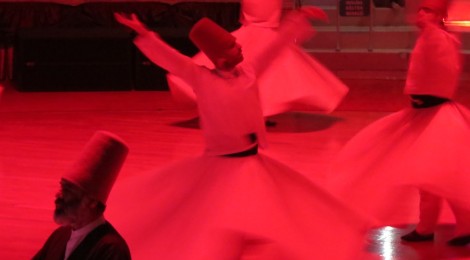
How to Whirl Like a Dervish
Welcome to Konya, spiritual home of The Order of the Mevlevi, a Sufi form of Islamic philosophy and mysticism founded after the passing of poet and philosopher Mevlana Rumi in the 13th Century A.D. Central to the Mevlevi practice is whirling, a spiritual dance performed to connect mind, body and spirit.
 Want to join the order and whirl like a Dervish? Here’s how:
Want to join the order and whirl like a Dervish? Here’s how:
- Apply. Enter the gates to the Dervish lodge and express your interest. Take off your shoes, sit with your legs under you on a special pelt and wait patiently for three days. If for some reason you are deemed unworthy, the dervishes will turn your shoes toward the door to break the news to you gently.
- Suffer. Congratulations! You made it through step one. Now your 1001 days of suffering begin. Dervishes-in-training take vows of poverty, do all of the dirty work for the other dervishes, and train for three years, including learning how to perform the seven parts of the whirling dervish sema ceremony. But first, the basics: turn in one place, counter clockwise, arms extended, with your right hand facing upward toward the heavens and your left hand facing downward to channel enlightenment toward the earth. Take care not to drift. The goal is to rotate in one spot, precisely around your own heart.
- Dress to whirl. You’ll need a symbolic costume of a white robe, a black outer robe which you’ll remove during the ceremony, and a tan conical felt hat representing your own tombstone.
- Be one with the universe. The sema ceremony is designed to connect dervishes with their innermost selves, with the turning of the earth, and with the orbiting of celestial bodies all at the same time. Everything turns, from the smallest electrons and protons to the most distant stars, and now you’re turning too.
- Be discrete. In 1925, as part of Atatürk’s new Turkish Republic reforms, the Mevlevi Order was outlawed and most dervish lodges were converted into museums (though it is believed decedents of the original whirlers are still practicing their faith and the sema ceremony in private). In 1957, partial rights were restored so as to allow the sema ceremony to be performed as a form of folk dancing, primarily to help promote Turkish tourism. UNESCO added the Mevlevi Sema Ceremony to its protected list of Masterpieces of the Oral and Intangible Heritage of Humanity in 2005. In Konya, the traditional music and dancing of the Mevlevi is still taught in conservatories and performed in educational ceremonies for the public.
Appreciating the intangible,
Alison

The Mevlana Museum in Konya, where Rumi’s tomb now rests, was once a practicing dervish lodge. Over 1.5 million people visit annually, primarily Turks making pilgrimages to visit and pray at Rumi’s tomb.
In addition to notes I took while touring the Mevlana Museum, here are a few references:
Mevlana Museum, Konya: http://muze.semazen.net
Wikipedia’s overview of the Mevlivi Order: http://en.wikipedia.org/wiki/Mevlevi_Order
Recent Comments